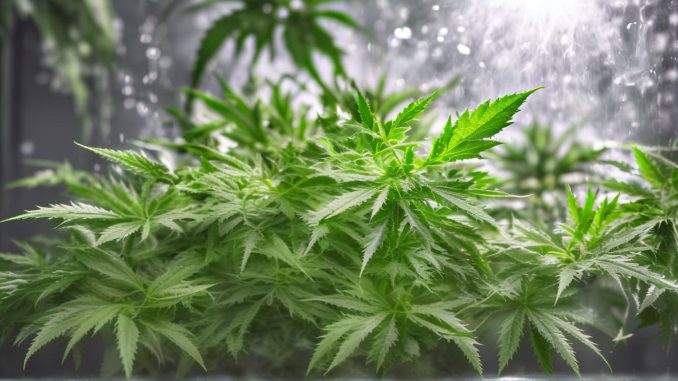
As an avid cannabis cultivator, I’ve learned firsthand the importance of meticulous humidity control, especially when nurturing young weed plants. From my experiences, I’ve come to understand that young weed plants are particularly sensitive to fluctuations in humidity levels. To ensure optimal growth and development, careful humidity management is essential. In this article, I’ll share insights gleaned from years of cultivation, shedding light on the delicate balance required to maintain the ideal environment for young cannabis plants. With refined techniques and the right air handling systems in place, growers can navigate the complexities of humidity regulation with confidence. Join me as we explore the intricacies of humidity control and uncover the secrets to fostering healthy, thriving young weed plants. Whether you’re a seasoned grower or just starting, this article promises valuable advice to help you master the art of cannabis cultivation.
Refining Humidity Levels for Cannabis Growth Phases
I’ve learned firsthand how critical it is to strike the right balance. Excess moisture can spell disaster, inviting mold and mildew to wreak havoc on tender plants. Through trial and error, I’ve honed my approach, ensuring that my young marijuana plants thrive in optimal humidity conditions. By carefully monitoring and adjusting humidity levels, I’ve safeguarded my plants against the risks of excessive moisture, allowing them to flourish and reach their full potential.
Optimal humidity for grooving cannabis
The optimal humidity for growing cannabis varies depending on the stage of growth. During the vegetative stage, humidity levels between 40% to 70% are ideal to promote healthy leaf development and growth. However, as the plants enter the flowering stage, it’s recommended to lower the humidity to around 40% to 50% to prevent issues like mold and bud rot.
Learn More About Marijuana Care
Growing cannabis requires attention to detail, especially when it comes to managing humidity levels. As someone who has embarked on the journey of cultivating cannabis, I’ve learned firsthand the importance of maintaining optimal humidity for young weed plants. Let me share some insights and tips based on my experience to help you navigate this crucial aspect of cannabis cultivation.
Seedlings/Clones
For seedlings and clones, maintaining the right relative humidity is essential for healthy growth. Aim for a humidity level of around 70-80% during the early stages to provide the ideal environment for these delicate plants to thrive.
Preventing Mold and Mildew
High humidity levels can create a breeding ground for mold and mildew, posing a threat to your cannabis crop. Investing in a dehumidification system and ensuring proper air handling in your grow room can help mitigate this risk and keep your plants healthy.
Tools for Measuring Humidity
To monitor humidity accurately, it’s important to use specialized tools that comply with the special restrictions and regulations for cannabis cultivation. Invest in a high-quality hygrometer to keep track of humidity levels and make adjustments as needed.
Creating a Humid Microclimate
In certain cases, you may need to create a humid microclimate specifically for your marijuana plants. This can be achieved using methods such as misting or placing trays of water near your plants to increase moisture levels in the air.
Effective Ventilation Strategies
Proper ventilation is crucial for maintaining optimal humidity levels in your grow room. Consider installing a dedicated air handling unit to ensure adequate airflow and prevent stagnant air, which can contribute to humidity-related issues.
By implementing these refined techniques and paying close attention to humidity levels, you can create the ideal environment for your young weed plants to flourish. Remember to seek advice before cultivating cannabis and stay informed about the best practices for maximizing growth and yield.
Assessing and Tweaking Humidity Levels for Cannabis Growth
When it comes to maintaining humidity levels for young cannabis plants in my grow room, precision is key. Too much moisture can invite mold and mildew, while too little can stunt growth.
Understanding the Relationship Between Temperature and Humidity
As a cannabis enthusiast, I’ve learned firsthand how crucial it is to maintain the delicate balance between humidity levels and temperatures in my grow room. When humidity levels soar, it creates the perfect breeding ground for mold and mildew, which can wreak havoc on my young weed plants. To combat this, I’ve invested in tools to measure relative humidity and temperature accurately. By closely monitoring these factors, I can adjust ventilation and temperature controls to create an optimal environment for my plants. It’s a delicate dance between warm air and water vapor, but mastering this balance ensures healthy growth and robust yields in my grow room.
Navigating Humidity and Temperature Throughout the Cannabis Growing Process
From the moment my cannabis seeds sprout to the final harvest, I’ve come to appreciate the critical role that humidity levels and temperatures play in the growth of my precious plants. During the early stages, maintaining optimal humidity levels is vital for the healthy development of seedlings. Too much moisture can lead to damping-off disease, while insufficient humidity can hinder growth. As my plants mature, I carefully adjust the humidity and temperature in my grow room to mimic the ideal conditions found in their natural habitat. This delicate balance ensures vigorous growth, robust flowering, and ultimately, bountiful yields. By staying attuned to the needs of my growing cannabis plants, I can create an environment where they thrive and flourish.
Conclusion:
Mastering the interplay between humidity and temperature is essential for successful indoor cannabis cultivation. By carefully monitoring and adjusting these environmental factors throughout the growth cycle, growers can optimize plant health, yield, and quality. Whether you’re a novice or a seasoned cultivator, understanding the impact of humidity and temperature on your indoor cannabis garden is key to achieving successful harvests.